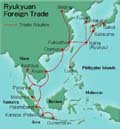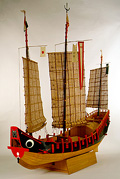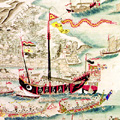 In the 10th to the 14th centuries in East Asia, merchants became increasingly active in trade between countries. Chinese merchants began to reside abroad in other East Asian countries for short terms to conduct trading. In Japan, the merchants of Kyushu and Seto conducted trade aggressively and enlarged their power. In this type of international atmosphere, the Three Kingdoms in Okinawa competed intensely and repeatedly with each other, finally achieving unity with the birth of the Ryukyu Kingdom. Throughout East Asia during this period countries emerged from confusion to reform and unification.
In the 10th to the 14th centuries in East Asia, merchants became increasingly active in trade between countries. Chinese merchants began to reside abroad in other East Asian countries for short terms to conduct trading. In Japan, the merchants of Kyushu and Seto conducted trade aggressively and enlarged their power. In this type of international atmosphere, the Three Kingdoms in Okinawa competed intensely and repeatedly with each other, finally achieving unity with the birth of the Ryukyu Kingdom. Throughout East Asia during this period countries emerged from confusion to reform and unification.
In 1368 the Ming Dynasty was established in China. The Ming, aiming to establish an international order with China as its center, called on neighboring countries to establish tributary relationships with China and established a trade embargo which prohibited free trade. In effect this policy instituted China as the leader and defined the position of neighboring countries. Only those that swore allegiance to the Ming Dynasty were given permission to engage in the lucrative trade with China by the Ming emperor. This is called the Sappo system in Japanese and by adhering to it, leaders in the neighboring countries legitimized their rule and received the benefits of trade with the more advanced China. The Three Kingdoms in Okinawa were also invited and joined in this type of relationship with China.
 The Ryukyus played an important role as an intermediary trader in this system by importing the fine trade goods from China and exporting them to other Asian nations. At the same time it collected products from Japan and East Asia for the trade with China. It built a vast system of trade routes on the seas to exchange goods with other countries.
The Ryukyus played an important role as an intermediary trader in this system by importing the fine trade goods from China and exporting them to other Asian nations. At the same time it collected products from Japan and East Asia for the trade with China. It built a vast system of trade routes on the seas to exchange goods with other countries.

